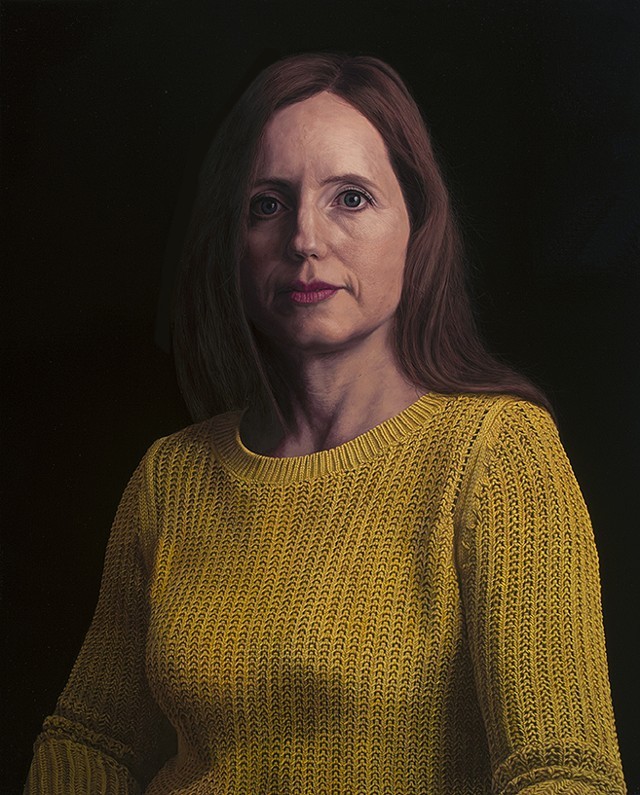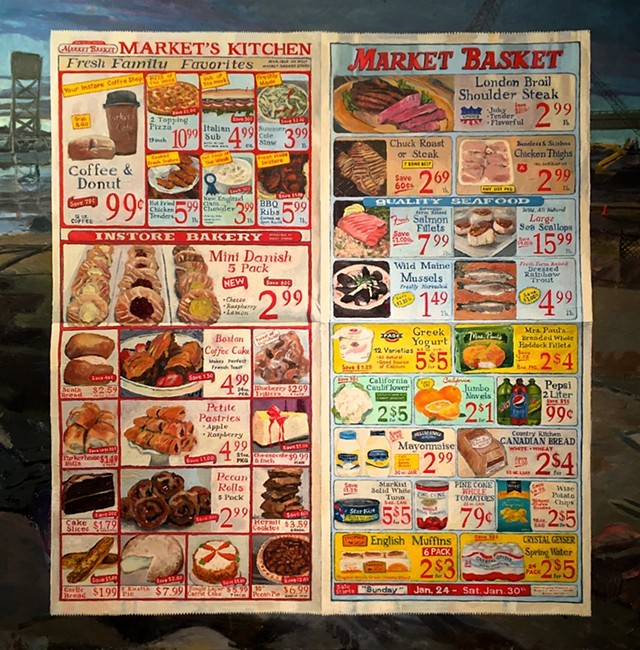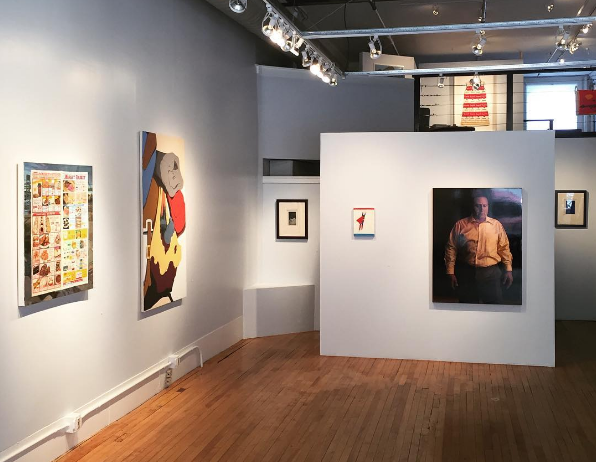by Meg Hahn
Able Baker Contemporary’s current exhibition, American Optimism, is a group show that looks at American consumer culture from an open and curious perspective, rather than one from anger and frustration. Through the inclusion of contemporary artists — Kathy Bradford, Philip Brou, Jarid del Deo, Kimberly Devries, Adam Eddy, Mark Gibson, Heidi Hahn, and David Humphrey — as well as historical pieces from Andy Warhol, Ray Johnson, and Grant Wood, the works provide a varied perspective and a broad timespan that support the exploration of art making through this lens. I sat down with co-owners and curators, Stephen Benenson and Hilary Irons, to discuss the development of the show, how they view the work, and the goals and future of the gallery.
Meg Hahn: People have really responded to the title of the show. Can you explain how you developed the idea for the exhibition and its title?
Stephen Benenson: Hilary introduced me to the work of Jarid del Deo and Philip Brou and suggested they would be really good in a show together. The more we talked about it, the more we both liked the idea of expanding it to more artists, some historic pieces, and work outside of Maine. When we talked about what tie Jarid and Philip’s work together, there was this interesting perspective about what it is to be American right now, and it felt that they were discussing Americanism without a lot of cynicism, which is unusual, I think for a lot of artists right now. We then started thinking about who else we can bring in and was operating in that way, and the title came from that. The idea of making a show about Americanism that wasn’t cynical was an interesting and challenging curatorial opportunity. It allowed for the possibility of some of a critique of America as well, but the starting point was American optimism.
Hilary Irons: One of the things too about making work about pop culture and consumer culture is that it is a lot easier to be negative and bitter and it’s much more difficult — from a theoretical standpoint — for the artist to have a more balanced perspective, or to be more playful or loving in response to this stimuli. That’s something I really liked about the way Jarid and Philip approached their subject matter. The narrative and continuity with the other work is something I really like, although it gets increasingly complicated with further artists that are included.
MH: Do you think these issues of American culture have been ongoing for centuries, especially looking at the relationship between the contemporary pieces with the more historical ones?
HI: I think a lot of prototypical American work — like Social Realism and New York School abstraction — all seem very earnest and it reflects on culture in a way that’s very idealistic or with a sense of utopia. But Pop Art immediately followed that with this kind of evil laugh, so I think historically this reintroduction of narrative into visual art followed the wake of Pop Art in the United States. It was really great that we were able to include these Warhol pieces because it makes that connection so clear. The Grant Wood piece also reconnects it back to the earlier narrative construct of Social Realism, so I think it’s a constant theme in artwork. I don’t know about for centuries, but probably. It’s interesting to see where the knife’s edge is between being critical in a way that’s disparaging and critical in a way that’s interested and curious, and Pop Art really underscored that.
SB: That was one of the ideas behind the show, where there’s something about American culture — and it may have to do with our youth as a nation — that does seem to separate us from Europeans, of a forward-looking optimism that I feel gets us as Americans into trouble a lot. But it is something that is inherently American and has been around since the formation of the country.

MH: I viewed several of these works, such as the ones from Adam Eddy, Mark Gibson, and somewhat Jarid del Deo and David Humphrey, with a sense of painting as object. Does this contribute to the ideas of capitalism and consumerism?
HI: I think the Adam Eddy works address that head on, of making these quasi-objects that are also really intentionally underscored as paintings. Not fancy paintings, but more like quick, easily-constructible pieces. What I really love about his work is that it’s so transparent, but he’s able to bring such an interest to it through the application of material. For me, Jarid del Deo is more of an old-fashioned painter that is really rooted in paint handling and a kind of conceptual springing off point. I definitely see that in the David Humphrey piece, the little Kathy Bradford painting too, definitely.
SB: Certainly the quintessential example of what you’re talking about is the Warhol Souper Dress. That is this marriage of art, consumerism, and an actual corporation, which produced it. It was at that moment in 1960 when the discussion of all that was at its nascent stage, so I think it’s good that you bring up art as object, between the relationships of these pieces.
MH: This show and the last both feature artists who have ties to New York and Maine. Do you see a regional difference or dialogue that is reflective in the work or the artists?
HI: I would say it’s a split between Maine and New York. Some of the artists we have are located in both places, and Adam Eddy lives in Boston, but the shows have been split that way. We’re committed to having some sort of regional underscoring in the exhibitions and we also want to bring work here that would be interesting to people in the area. There’s so much interchange and conversation between Maine and New York.
SB: I think there are lots of artists moving to Maine because the cost of living is lower and the pace of life appeals to people. But New York will always be the center of the art world in terms of the United States or the Northeast. We feel really fortunate to be able to draw work from there to get a bigger picture of what’s going on right now.
HI: It’s really nice to have that dialogue, but it’s also very interesting how Maine and New York are these two places where a lot of artwork is made. Of course artwork is made all over the country, but it does seem like historically there is a connection.
MH: Would you say most of the shows you have planned next are split between Maine and New York too?
HI: Yeah, the ones we have set up next are similar in structure. We want to keep the window open to other places, but we also feel like there is so much interesting work around here. It’s really important to represent that.
It’s interesting to see where the knife’s edge is between being critical in a way that’s disparaging and critical in a way that’s interested and curious, and Pop Art really underscored that.
— Hilary Irons
MH: How did you choose the artists and works for the show? You said earlier this show started with Jarid and Philip…
HI: Right. We just asked certain people if they would be in the show. Adam Eddy, for example: I visited his studio and thought any of the work would fit well with the theme. There are a lot of amazing studios I visited at that time and the thematic link was important. With Jarid, he works on them for so long that he doesn’t have a massive output, which you can probably see. With Philip, we had a studio visit and decided on the work we thought would be strongest in the space. Then for the New York people, that was also very mixed. It depends on what people make and what kind of access we have to their studios. We have to be very flexible in how we acquire the work and approach artists because it needs to make sense for them and not just for us.
SB: It’s funny, we’re using a model that’s closer to mega-galleries in New York but on a comically smaller scale. The idea is that they put up “museum shows” or “blockbuster shows” where there might only be one or two pieces for sale. They’re curating it like a museum to create context and to make the most interesting shows they can. We’re doing it from the other end with local art and then bringing in other art to round it out, and create context. We want to continue drawing from people’s private collections and have work that’s not for sale. What keeps us interested is curating the most interesting shows we can. We reached out to private collectors we knew had Warhols and Ray Johnsons, because we wanted those pieces in the show. There’s a bit of give and take in terms of what we can get our hands on.
HI: We have to be open to what spontaneously comes up. I think private collections are interesting because a lot of the time it isn’t for sale, but strengthens the message of the show and makes it more complex and interesting, so it’s important for us to keep doing that and think about how we can work more historical pieces in over time.
SB: Yeah, I’ve really enjoyed the challenge of trying to get them and fit them into the shows.
MH: Was it intentional to follow You, Yes, You with more of a mix between representation and abstraction? For the future are you trying to be conscious of having a bit of both or having some shows that are more focused on one than another?
HI: It’s interesting because the curation of that show was all organized by Meghan Brady, who was the artist we picked. One of our goals is to maintain that artist-context series, where we invite artists to curate a show. We have one show like that in its embryonic stage. The work that she was interested in wasn’t representational, but it was very cohesive and played well against the other work. This show is different because Stephen and I put it together ourselves, so it depends on who sets the shows up. It’s not always going to be us, and in fact we’re hoping that over time there will be more and more outside input and influence in the curatorial function of the gallery.
SB: It wasn’t intentional, but I like that we followed You, Yes, You — which I thought was a really smart show about a particular lineage of painting that’s happening right now that’s awkward, almost comic-based abstraction — with a show that has more representation. It’s not something I think we’ll be thinking a lot about, but it worked out nicely in this case.

MH: How are you planning for future shows? Do you have a curatorial wish list?
HI: We kind of do — but it’s secret.
SB: Hilary and I have talked a lot about shows that sound exciting to us and then we work backwards and figure out how to put them together. We have that luxury right now to enjoy the process of curating the shows we want, but there are going to be different models from these artist-context shows to more directly curated shows. It’ll be rare that shows will resemble solo shows because we want to get as much variety and ability to show different pieces from different places and collections.
HI: Right. And we want to be able to contextualize the work that we’re showing. There is a show that will function more like a solo show, but since we have this mezzanine level, I’m hoping to curate a little show there that can reflect on the work in the main exhibition space and put it in a context that has more to do with the local production of the area. We want to really be flexible in what we’re trying to say. To not privilege one voice over another and to have an open approach. In terms of a curatorial wish list, my wish is a very dynamic artist-context series, with a lot of interesting people contributing and a really robust group of people to talk to and think about. Right now we have a few people we’re working with, but that’s something we’re definitely hoping to expand.
SB: We also take submissions and curatorial proposals from people, and in fact we’re working with a submission now.
MH: What led you to open Able Baker and why is it important to have artist-run galleries, especially in Portland?
HI: A couple years ago there were a lot of really great galleries in Portland and others are closing soon. It’s in a city where there’s a lot happening. It’s in a historically rich area that has always had a lot to do with the visual arts and I felt like it didn’t make sense that there wasn’t a space. The space we got was all surprising and quick, which was great.
SB: It’s really a shame there aren’t more venues for contemporary art in Portland. Hilary and I are both painters and tend to be painting-centric in the way we think about art and the art world. There are venues doing a good job with alternative art, performance, and film, but we wanted to really focus on painting, although we’re going to show things that aren’t paintings sometimes.
HI: One of my main goals for Able Baker is that people will come here and think, “Oh, I can open a gallery,” and maybe it will lead to the creation of other art spaces, whether they’re alternative spaces, artist-run spaces like this one, or a more traditional commercial gallery structure. To reinvest the art scene here with interesting new life will hopefully be something good that will come out of this. In terms of artist-run spaces, the best thing for us so far is how we’ve gotten to work with so many great artists through putting shows together, getting work, logistical things, and it becomes a community effort. If it was a more rigid commercial structure I think it would be more closed off for us.
SB: Painting — being an artist in general — can be very solitary and I think it’s been great to have this as a way to link into a community and each other. It ends up fulfilling that need.
American Optimism runs through July 29, 2016 at Able Baker Contemporary in Portland.
Able Baker Contemporary
29 Forest Avenue, Portland, Maine
Open 1–5:30pm Thursday, Friday, and Saturday or by appointment. Free.
This interview has been edited for clarity. Meg Hahn is both an intern at The Chart as well as at Able Baker Contemporary this summer.

Meg Hahn currently lives and works in Portland, Maine. She graduated from Maine College of Art with a BFA in painting and a minor in Art History. Meg was a finalist for the Joseph A. Fiore Painting Prize (Damariscotta, ME), and has attended the Vermont Studio Center (Johnson, VT), Hewnoaks Artist Colony (Lovell, ME), the Monhegan Artists’ Residency (Monhegan Island, ME), and will be a resident this summer at The Sam and Adele Golden Foundation Residency Program. She is also interested in other forms of art practice including curation. Meg is a co-director at Border Patrol (Portland,ME) and works out of the SPACE Studios building.

